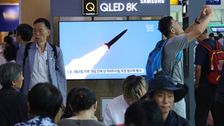
SEOUL, South Korea (AP) — North Korea on Wednesday fired several unidentified projectiles off its east coast, South Korea’s military said, less than a week after the North launched two short-range ballistic missiles into the sea in a defiance of U.N. resolutions.
Observers say the launches were aimed at ramping up pressure on the United States to make concessions as the two countries are struggling to resume diplomacy on the North’s nuclear weapons program.
South Korea’s Joint Chiefs of Staff said in a statement the latest launches were done from the North’s Hodo peninsula on the east coast, a regular weapons launch site. It said South Korea’s military is monitoring for possible additional launches by North Korea.
It wasn’t immediately known exactly what North Korea fired or how far the projectiles flew.
The launches came six days after North Korea fired two short-range ballistic missiles that Seoul officials say flew 600 kilometers (370 miles) before landing off the North’s east coast.
The latest launches also came hours after a senior U.S. official said President Donald Trump has sent mementos from his brief visit to an inter-Korean border town late last month to Kim.
The official said a top staffer from the National Security Council hand-delivered photographs from the June Trump-Kim meeting at the Korean Demilitarized Zone to a North Korean official last week. The Trump administration official spoke on the condition of anonymity because the official wasn’t authorized to speak publicly.
The DMZ meeting was the third summit between Trump and Kim since they first met in Singapore last year. Diplomacy between North Korea and the United States later fell apart as the second Trump-Kim summit in Vietnam in February ended without any agreement. In Vietnam, Trump rejected Kim’s demand for widespread sanctions relief in return for dismantling his main nuclear complex, a partial disarmament step.
During the DMZ meeting, Trump and Kim agreed to resume the nuclear diplomacy in coming weeks, but there hasn’t been any known meeting between the countries. Some experts say North Korea wants a U.S. promise to ease sanctions, accept a slow, step-by-step disarmament process by North Korea or make other concessions once the diplomacy restarts.
Despite a recent lack of progress in nuclear diplomacy, both Trump and Kim have said they have maintained good relations with each other. After Thursday’s missile launches, Trump tried to downplay the significance of the tests, saying that “short-range” was the most important word. He said North Korea fired “standard” missiles many countries possess.
After entering talks with the U.S., North Korea has suspended nuclear and long-range missile tests, and Trump views that as a proof that his North Korea policy is working well and has eased the danger of a war with the North. In 2017, Trump and Kim exchanged crude insults and threats of destruction as Kim was orchestrating a series of high-profile nuclear and missile tests as part his efforts to achieve his stated goal of acquiring nuclear missiles capable of reaching the continental U.S.
Thursday’s launches were a violation of U.N. Security Council resolutions that ban North Korea from engaging in any launch using ballistic technology. While the North could face international condemnation over the latest launches, however, it’s unlikely that the nation, already under 11 rounds of U.N. sanctions, will be hit with fresh punitive measures. The U.N. council has typically imposed new sanctions only when the North conducted long-range ballistic launches.
North Korea’s state media said Thursday’s missile tests, supervised by Kim, were designed to deliver “solemn warning” to South Korea over its purchase of high-tech U.S.-made fighter jets and its plans to conduct military drills that Pyongyang sees as an invasion rehearsal. The North’s state media report avoided a direct criticism of the United States.
South Korea’s military said the flight data of the weapon launched Thursday showed similarities to the Russian-made Iskander, a short-range, nuclear-capable missile. A North Korean version could likely reach all of South Korea — and the 28,500 U.S. forces stationed there — and would be extremely hard to intercept.
REAL LIFE. REAL NEWS. REAL VOICES.
Help us tell more of the stories that matter from voices that too often remain unheard.
Credit: Source link